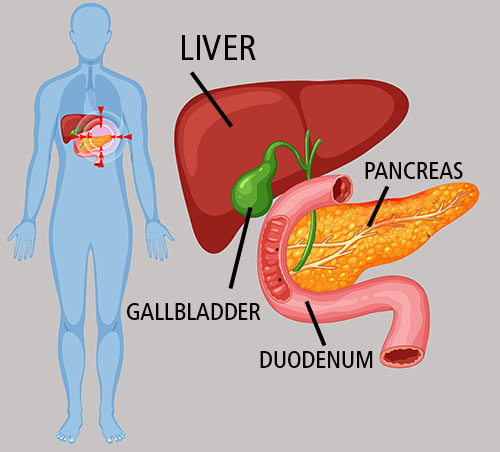


The human digestive system is a complex interplay of various organs that work together to break down food into its components, process it, and make it usable for the body. The liver, gallbladder, and pancreas play a particularly crucial role in processing nutrients, especially fats and carbohydrates.
In this article, we will explore their functions in detail and explain how they collaborate.
1. General Explanation of Their Functions
a) Liver
The liver is the largest internal organ in the human body and performs a wide range of vital functions. It produces bile, which is necessary for fat digestion, stores vitamins and minerals, and filters toxins from the blood. Additionally, it regulates blood sugar levels by storing glucose as glycogen or releasing it depending on whether the body needs energy.
b) Gallbladder
The gallbladder is a small, pear-shaped organ located below the liver. Its main task is to store and concentrate bile produced by the liver. When fatty food enters the small intestine, the gallbladder releases bile, which emulsifies fats—breaking them into small droplets—so they can be digested more easily.
c) Pancreas
The pancreas produces digestive enzymes that become active in the small intestine, breaking down proteins, carbohydrates, and fats. It also produces hormones like insulin and glucagon, which regulate blood sugar levels.

2. How Does the Body Process Consumed Food?
The digestive process begins in the mouth, where food is mechanically broken down by chewing and enzymatically pre-digested by saliva. In the stomach, the food is further processed and turned into a pulp called chyme. This eventually enters the small intestine, where nutrient absorption takes place.
In the small intestine, specialized structures like villi extract water, vitamins, and nutrients from the food. These nutrients are transported via the bloodstream to the liver, which processes and stores them. This system is supported by the liver, gallbladder, and pancreas:
• The liver produces bile, which is needed for fat digestion.
• The gallbladder stores and releases bile when needed.
• The pancreas provides enzymes and regulates blood sugar levels.
3. What Do the Liver and Pancreas Do When Consuming High Sugar?
When we consume large amounts of sugar—such as through sugary drinks, chocolate, or sweets—the blood sugar level rises rapidly. To regulate this spike, the pancreas releases insulin, which prompts cells to absorb glucose and use it as energy. Excess glucose is stored in the liver as glycogen.
However, chronically high sugar consumption can overburden the pancreas, leading to insulin resistance or even diabetes. The liver can also be damaged, as excess glucose is converted into fat and stored in the liver, potentially leading to fatty liver disease over time.
4. What Happens with a High-Fat Diet?
When consuming fatty foods—like fries, fried foods, or fast food—bile plays a crucial role. The liver produces bile, which is stored in the bile ducts and released by the gallbladder. The bile emulsifies fats in the small intestine so they can be more easily broken down by the digestive enzymes from the pancreas.
Saturated vs. Unsaturated Fats
Fats can be divided into two main groups: saturated and unsaturated fats. Saturated fats, often found in animal products and fried foods, increase cholesterol levels and can burden the gallbladder. Unsaturated fats, found in plant oils, nuts, and fish, are considered healthier as they positively affect cholesterol levels.
However, excessive consumption of fatty foods can lead to serious long-term problems, such as gallstones, an enlarged liver, or inflammation of the pancreas (pancreatitis).
Long-Term Effects on the Liver, Gallbladder, and Pancreas
Chronically unhealthy eating habits can have severe consequences for these organs:
• Liver: Fatty liver can lead to hepatitis or even cirrhosis.
• Gallbladder: Too much saturated fat promotes the formation of gallstones, which can cause severe pain.
• Pancreas: High sugar intake or alcohol abuse can trigger pancreatitis, a painful inflammation of the pancreas.
Conclusion:
Take Care of Your Liver!
To maintain the health of your liver, gallbladder, and pancreas, a balanced diet is essential. Avoid fatty and sugary foods that are fried or baked at temperatures above 100°C, as they can be harmful. Better alternatives are foods cooked in water, like soups or steamed vegetables.
Here’s a list of foods to avoid:
• Sugary drinks (soft drinks, energy drinks)
• Sweets (chocolate, cakes, cookies)
• Fried foods (fries, chicken nuggets)
• High-fat meat products (sausages, fatty cheese)
Instead, opt for healthy alternatives:
• Whole grain products
• Fresh fruits and vegetables
• Lean meats and fish
• Plant-based oils (olive oil, rapeseed oil)
A conscious diet and regular exercise are key to a healthy liver and a functioning digestive system. Give your organs the care they deserve!
Conclusion: The collaboration between the liver, gallbladder, and pancreas is essential for efficient digestion and nutrient absorption. Through mindful eating, we can support these organs and stay healthy in the long run.
